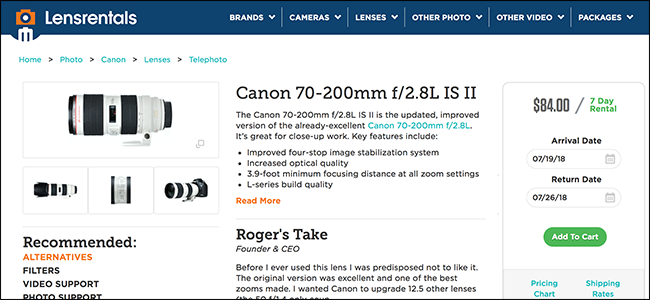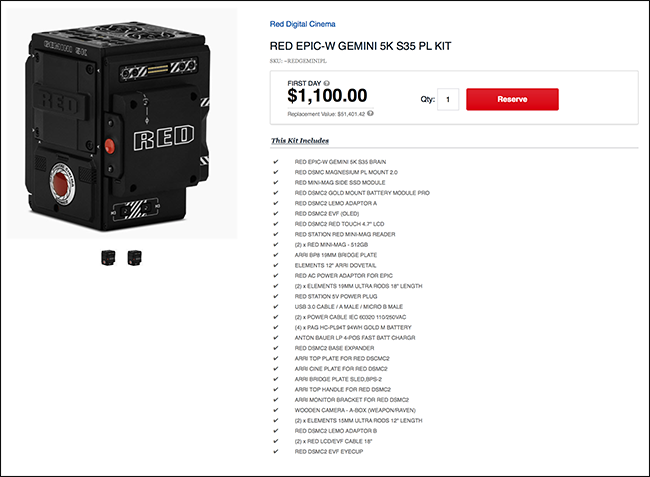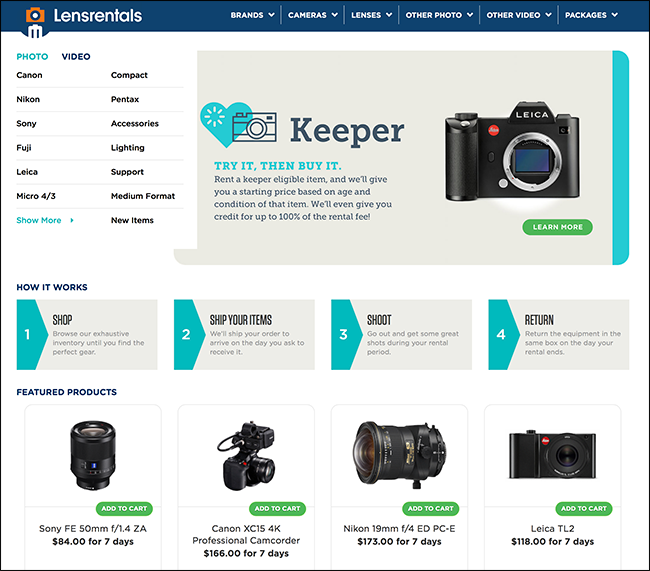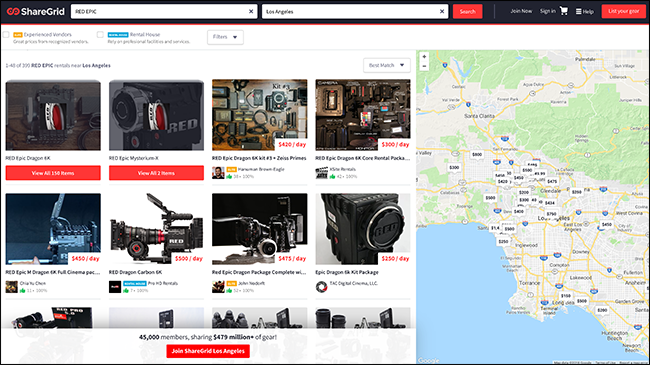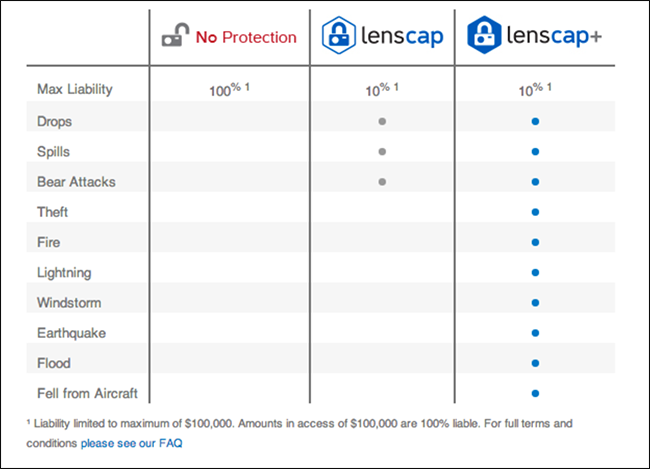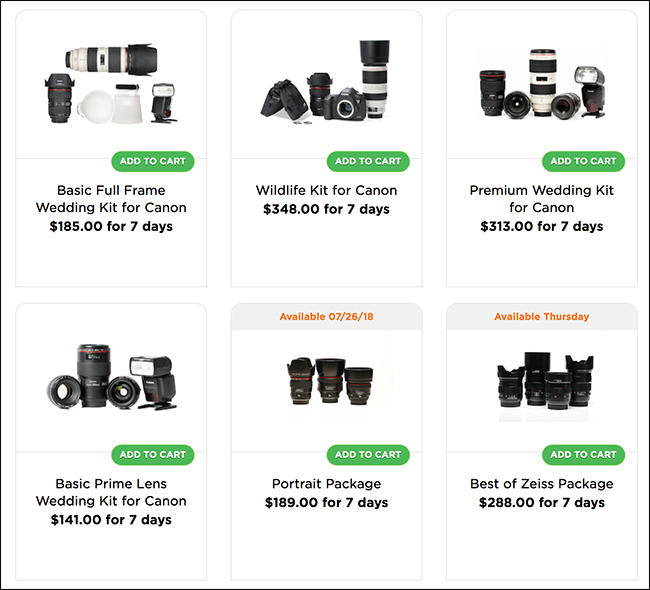Quick Links
Photography and videography gear is expensive. Professional equipment starts at a few hundred dollars and goes up to hundreds of thousands. You might dream of shooting with a RED EPIC camera, but you probably don't want to pony up the $19,000+ to own one. The thing is, there’s another option: rental.
It might surprise you, but the odds are that a lot of the equipment used in your favorite movies and TV shows isn’t owned by the people or company shooting it. Instead, it’s rented from a commercial agency. Why buy a crane just for a single scene when you can rent one for a fraction of the cost? Hollywood is built on rented gear.
And it’s not just Hollywood productions that can rent stuff. You can do it too. If you really want to shoot a RED EPIC, you can rent one and all the other gear you need for $1,100 per day. Sure, that’s a hell of a lot of change, but it’s way less than the $50,000+ it would cost you to buy it all yourself. Most gear also goes out for nowhere near that price. You can get a $2,000 lens like the Canon 70-200 f/2.8 L IS II for an incredibly reasonable $84 per week.
When to Rent Photo and Video Gear
Rental is a huge part of the professional industry, but you don’t need to be planning a major shoot to rent some gear. There are lots of other reasons.
- To try something out before buying: Most local camera shops have some popular gear available to rent. If you’re considering buying something and it’s in their rental stock, you can normally arrange to rent it for a few days. If you decide to buy, then the rental fee you’ve paid gets deducted from the purchase price. It’s one of the big reasons to support local shops.
- To see if something is for you: It’s really difficult to take good sports photos without a telephoto lens. If you think it’s a genre of photography you might enjoy, rather than dropping loads of cash on a lens you might not use, you can rent a telephoto for a sports game or two and see how you like it. I’m considering switching to mirrorless cameras, so I plan to rent a full Sony A7III setup for a week and see how it goes.
- When you’re only going to use it a few times: I occasionally have to use studio lights to take portraits but I don’t do it anywhere near enough to spend the money on a real set up. Instead of spending $2,000, I just spend $150 once or twice a year. It also means I’m always shooting with high quality, new gear.
- Just for fun: Let’s be honest, playing with amazing camera gear is fun. If you’ve got a few hundred dollars and you’ve always wanted to try out some ludicrously expensive bit of kit, just rent it. You’ll be able to fulfill your medium format or movie making fantasies without taking out a mortgage.
Where to Rent Gear
The simplest place to rent gear is from local camera shops. They normally have a supply of popular, versatile gear like 24-70mm and 70-200mm lenses, studio lights, and full frame DSLR bodies. You can also check out the condition of it and the staff will teach you how to use it. The only downside is that if you’re looking for something obscure, they might not have it.
If you want a wider selection, your best bet is Lensrentals. They’re the biggest online photo rental store and their gear selection is essentially limitless. They almost certainly have whatever bit of obscure photography or videography gear you want. The prices are good and they ship to all 50 States. You can even buy any rental gear you don’t want to send back.
Your final option is to look at a peer-to-peer rental service. It’s one of the few “Airbnb for X” ideas that actually makes sense. People who have camera gear they’re not currently using can list it for other people to rent. It lets them offset some of the cost of their equipment and lets you rent it for less. The two biggest services are KitSplit and ShareGrid. There might not be someone nearby with what you need, but if there is, it’s probably the cheapest option.
Tips for Renting Photo and Video Gear
Insure, insure, insure. Seriously, you do not want to be on the hook for tens of thousands of dollars worth of gear because your careless friend tripped on the tripod. Cameras and lenses are just too fragile and too expensive for you not to take out some kind of protection. If you’re a professional photographer, your insurance policy may cover it. If not, your options depend on where you’re renting from. Ask your local shop what they offer. Lensrentals sells their own insurance (it even covers bear attacks). KitSplit and ShareGrid can provide insurance for a fee, as well.
Inspect the gear before you rent it or as soon as it arrives. Rental gear is by its very definition used, so there’s a good chance there are some scuffs and scratches. It won’t affect the quality of your work but you don’t want to be blamed for a scratch that was there before you got it. I find the best thing to do is to take a quick video of the gear and talk through any issues I see; that way I can use the video if there’s ever any issue.
Make sure you rent the accessories too. Most of the time you can rent a kit with all the cables, chargers, modifiers, and the like, but if you’re going á la carte, be careful to get everything you need. There’s no point renting studio flashes if you don’t get a wireless flash trigger too.
Renting gear for an occasional shoot is a great way to break into different areas of photography. Unless you’re shooting sports week in and week out, there’s no point owning a telephoto lens. If you just need the stuff every few months, renting is the way to go.

